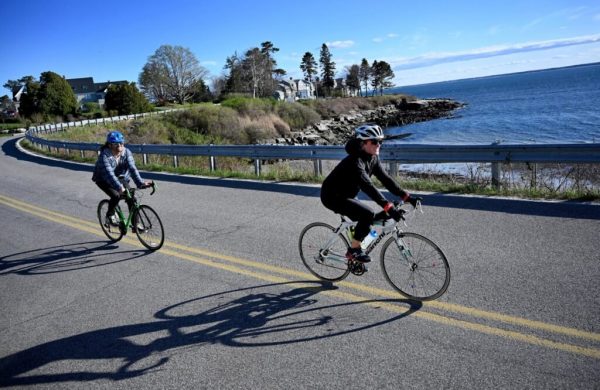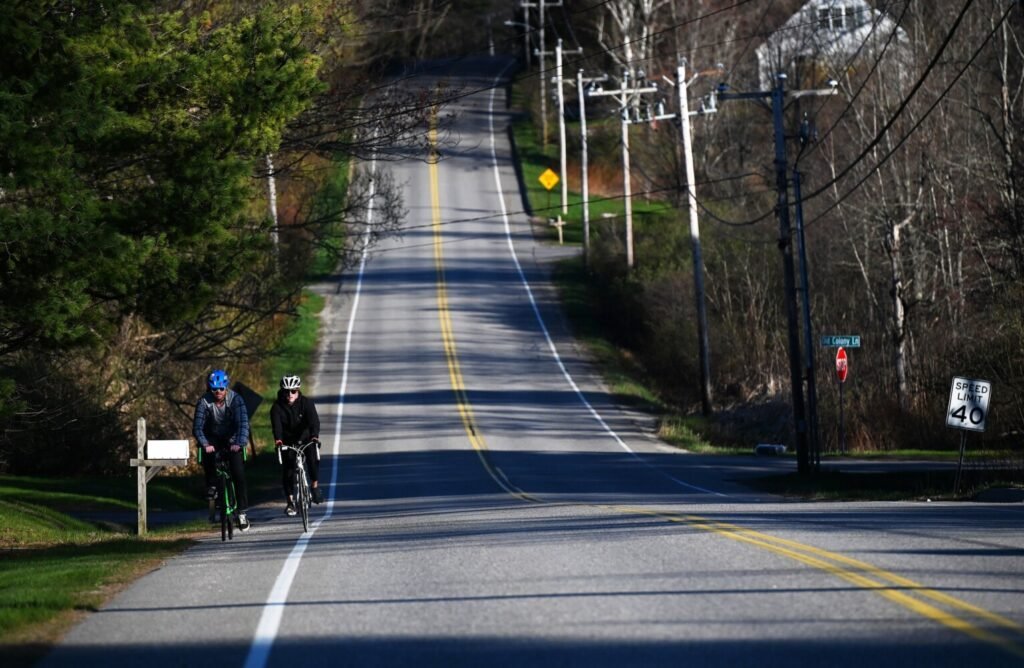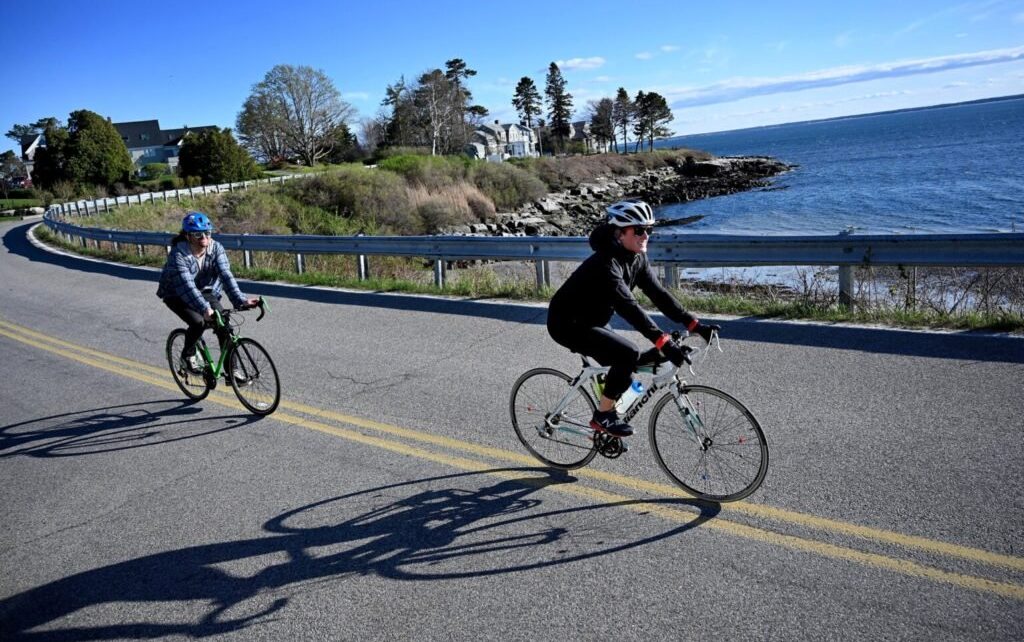
Trevor Toohey and MacKenzie Bowker, both of Scarborough, bicycle on a sunny evening last week along Black Point Road on Prouts Neck – one of Bowker’s favorite routes. Shawn Patrick Ouellette/Staff Photographer
When Bob Bowker’s daughter, MacKenzie, asked for ideas on where to ride her bicycle in Maine this spring, he had an easy answer. Bowker, founder of the popular Maine Lighthouse Ride, suggested she try the southern portion of the 100-mile lighthouse route, where coastal views abound.
The expansive views of the Atlantic Ocean and rocky beaches in the Kennebunks delighted MacKenzie Bowker, a jewelry maker and bike tour guide.
“I’m trying to ride local,” MacKenzie Bowker said. “I wanted something along the water. It’s nice to have those views. (My boyfriend and I) took a couple of different roads just because they went closer to the water. There was slightly less traffic than normal. So we were able to cruise around and not have to worry about out-of-staters.”
Bowker is not alone in seeking out new bicycle routes at this time. Bike paths have been busy and crowded during the pandemic, so many cyclists are looking for other options, bike advocates say.
“I see a lot of riders out riding by themselves now,” said Victor Langelo, ride director for the Merrymeeting Wheelers Bicycle Club. “The group rides are not taking place, because it’s not socially responsible right now. But there are a lot of bikes on the roads.”
Resources are plentiful for cyclists wanting to explore new roadways. The Maine Department of Transportation has an online directory of 33 scenic bicycling routes across the state, with maps and cue sheets. Other bike routes and maps for scenic road loops are offered by clubs and touring companies.
The Merrymeeting Wheelers Bicycle Club in the Midcoast has 40 road routes listed on its website. While the 220-member club has paid memberships that gives riders access to their group rides and social events – they also want to get more people out cycling, Langelo said.
Some of the more popular road routes in southern and central Maine include the Bunganuc Road loop in Brunswick – a favorite of Langelo’s. It leaves from the Brunswick town green and heads out Harpswell Road before turning onto Middle Bay Road, where it winds along quiet, rural roads near the coast. It ends up on Bunganuc before heading back toward the downtown – but through the zigzag coastal section the ride takes in views of rocky Maquoit Bay. A map of the 16-mile loop can be found here.

Trevor Toohey and MacKenzie Bowker, both of Scarborough, bicycle along Pleasant Hill Road in Scarborough on a sunny weekday evening in May. Photo by Shawn Patrick Ouellette/ Staff Photographer
A popular ride closer to Portland is the out-and-back route following Route 88 in Falmouth to Gilman Road and out to Cousins Islands in Yarmouth. Some sections of the Falmouth road lack a shoulder, but the hilly route rises to sweeping scenes of Casco Bay. And while the ride over the Cousins Island bridge has no shoulder – that view is all ocean. Round trip it’s 20 miles.
Quieter roads full of farms and a fishing villages can be enjoyed further down the coast on the southern-most section of the Maine Lighthouse Ride (the one Bob Bowker favors). Take Ocean Avenue in Kennebunkport to where it becomes Shore Road and follow it to Wildes District Road, then turn right. This quiet, rolling byway leads to Route 9 in Cape Porpoise and from there on to Goose Rocks Beach at the Clock Farm corner. After that detour at Dykes Road, which takes in salt marshes and seabirds, head north on Route 9 a few miles to Fortunes Rocks Road, and follow it to Biddeford Pool and out around the peninsula. This last stretch is full of beaches, ocean views and pounding surf – and just as good on the return ride. The entire out-and-back route is 30 miles, and found here.
Of course, the Prouts Neck ride in Scarborough down Black Point Road is arguably the most popular road ride in southern Maine. Ride to the Neck and back, then take Route 77 to Higgins Beach and onto Two Lights Road before returning. That gets you a solid 30 miles.
Cyclists should take caution while navigating roads with traffic. Maine DOT reported that in the 10 years from 2009 to 2018 there were 16 bicycle-related fatalities.
“I would never assume any rider is safe. Anytime there is traffic, there is the opportunity for conflict with a pedestrian or bike,” said Patrick Adams, the department’s bicycle and pedestrian coordinator.
That in part may explain why some bike advocates hope that the pandemic could spark a more bike-centric culture in Maine. Motor vehicle traffic has decreased significantly with more people working from home and many businesses closed.
Nationally – even globally – municipalities are considering closing streets to help businesses and restaurants expand seating or allow for social-distancing lines outside, said Jim Tasse, the assistant director at the Bicycle Coalition of Maine.
The open-street movement – which refers to city streets being closed to vehicle traffic – already has taken hold in Glasgow, Scotland, Cologne, Germany; and in the United States in Denver, Philadelphia, New Orleans and Minneapolis, to name just a few. Here in Maine, the Rockland City Council discussed closing part of Main Street as a way to help businesses and restaurants maintain social distancing among customers.
Tasse said if even one Maine community closed some streets to provide for social distancing – it could offer a view into how much the public might enjoy bike and pedestrian-friendly promenades.
“Everyone is sort of enjoying walking outdoors and not feeling they are in a motorized jungle. How do we make this more permanent? There’s been a lot of chatter about this nationally,” Tasse said. “What I love about the notion is that we can use public streets for a function besides a thoroughfare for motor vehicles.”
Hiking in Maine: Use these compass basic skills to avoid a runaround
Hunting: Coming across a virus among turkeys a reason to stop and think



Invalid username/password.
Please check your email to confirm and complete your registration.
Use the form below to reset your password. When you’ve submitted your account email, we will send an email with a reset code.